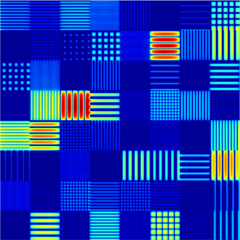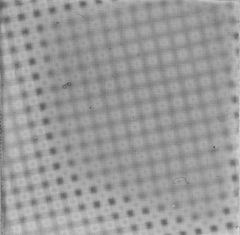'Lab-on-chip' micro- and nano-fluidic devices promise to bring reliable healthcare to every corner of the globe. To be usable in the field, these new devices must be realized in materials that are affordable, transparent and mechanically tough. Polymeric materials are particularly appealing, including those made from fibers, such as paper and fabric.
Fast simulation of hot micro-embossing. We have developed an extremely fast way of simulating hot micro-embossing, a promising technique for the production of microfluidics. In hot embossing, a polymeric substrate is heated until it softens, and a hard, reusable, patterned stamp is then pressed into the substrate before both the stamp and the substrate are cooled and then separated. A pattern to be hot-embossed could contain thousands of features ranging in diameter from less than a micrometer to several millimeters. An embossing temperature, load and loading duration must be selected such that every cavity on the stamp is filled with polymer as required. The technique that I have developed allows these processing conditions to be efficiently selected for a given design and polymeric material, and is fast enough to be used iteratively to guide the design of complex patterns.
Hot demolding for micro-embossing. When the stamp and substrate are cooled at the end of a hot-embossing cycle, differential thermal contraction occurs which can induce damaging stresses. It is therefore appealing to remove the stamp from the polymer at as high a temperature as possible. Indeed, limiting the process's temperature swing can enhance manufacturing throughput. But demolding at too high a temperature runs the risk of distortion of the embossed micro-structures. In collaboration with Matthew Dirckx in the Laboratory for Manufacturing and Productivity at MIT, I investigated the hot demolding of one candidate material, PMMA, and proposed reasonable hot-demolding parameters.
Moire-based distortion measurement. When a hot-embossed polymeric layer is demolded at elevated temperatures, global distortions of the layer can occur. While usually well below 1% in magnitude, these distortions can impede multi-layer alignment. Zhiguang Xu and I have demonstrated a moire-based technique for determining the distortions of a hot-embossed polymeric plate, several cm square, embossed with a periodically micro-patterned stamp. The technique requires only a standard flatbed document scanner and a printed reference pattern, and has no need of precise positioning of either sample or reference.
Bonding multiple polymeric layers. Fluidic devices require encapsulation, and that usually means bonding multiple polymeric layers together. Bonding has been demonstrated with adhesives, solvents, laser welding, and the interdiffusion of polymer chains at a heated thermoplastic interface. Thermal bonding is particularly worth pursuing because no extraneous materials need to be introduced to the interface. We need ways of enhancing bond toughness while limiting heat-driven distortion of any nanostructures at the interface. Exposure of the surfaces to a plasma before bonding is a much-discussed but little-understood toughness-enhancing approach: it is thought to shorten polymer chains and lower the softening temperature of a film of material near the bonded surfaces. To investigate these processes comprehensively, we need fast, compact, and sometimes non-destructive bond-testing techniques. To this end, I have invented a micro-crack-opening method for measuring the work of fracture of bonded polymeric interfaces.


